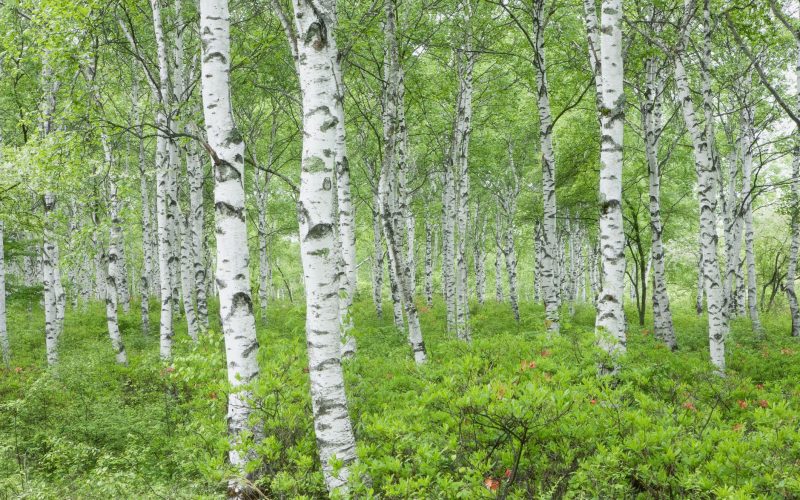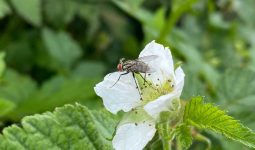There are many different types of birch trees. Birch trees are the Betulaceae family of plants and belong to the genus Betula.
They are typically small—to medium-sized trees and shrubs found in temperate Northern Hemisphere zones. Some cultivars form shrubby clusters.
Others form clumps with trunks, while others grow as traditional single-trunk trees.
Furthermore, the birch tree is well-known for its beautiful, white-to-gray peeling bark.
They thrive in wet wooded areas and are likely found in cooler climes.
However, when planted in landscapes, they provide more than just shade because they are great show-stoppers.
If you’re considering putting birch trees in your yard, you should first learn about the different types.
I’ll now go over some of the more common and intriguing birch tree types.
If you’re thinking of planting a birch in your garden or yard, remember that most birch have shallow root systems and are susceptible to drying out in arid weather.
1. Bog Birch (Betula pumila)
Bog birch is a clump-forming, medium-sized shrub that thrives in moist areas. The plant tolerates flooding, alkaline soil, clay soil, and road salt.
Furthermore, when planted in residential settings, bog birch thrives in swampy places or around bodies of water. For rain gardens, it is a fantastic choice.
Swamp birch, glandular birch, dwarf birch, and resin birch are other frequent names for this tree.
2. Paper Birch (Betula papyrifera)
This species is only found in the northern United States and Canada. It gets its name from the papery white bark that peels off layers like paper.
Paper birch is a type of birch tree that produces yellow flowers in the fall. It can grow in bunches or from a single trunk and can reach a height of 45 to 100 feet.
Furthermore, It was also known as the canoe birch because Native Americans widely employed it in constructing canoes.
On the other hand, its catkins provide wildlife with a regular food supply. This is one of the types of birch trees resistant to birch bronze borers.
3. River Birch (Betula nigra)
This fast-growing birch has earned a reputation as a popular landscape tree. It might take the form of a clump or a solitary trunk.
Its bark is renowned for its reddish-brown color, which exfoliates to reveal salmon-pink layers.
Furthermore, it has dark green, ovate leaves that turn butter-yellow in the fall. It’s one of the few heat—and drought-resistant birches, growing 40-70 feet tall and resistant to bronze borers.
4. Cherry Birch (Betula lenta)
The cherry birch is a big tree with only one main trunk. Because of its gleaming red-brown bark and golden foliage, it is excellent for lawns and naturalized areas.
The bark develops vertical fissures on mature trees that form irregular scaly plates, similar to cherry tree bark.
The tree blooms in April and May and produces fruiting catkins from August to October, providing food for deer, moose, rabbits, and various birds.
This tree not only draws lovely butterflies to the scenery but also resists the bronze birch borer, which can kill other birch species.
Broken twigs have a fragrant wintergreen scent, and birch beer is made from fermented sap.
Furthermore, Other common names for cherry birch in different parts of the country include black birch, sweet birch, mahogany birch, Virginia roundleaf birch, and spice birch.
5. Dwarf Birch (Betula nana)
Betula nana is a small dwarf shrub that grows wild in arctic and cool temperate environments, particularly tundra.
It thrives in various settings but prefers wet, well-drained locations with rocky, nutrient-poor, acidic soil. It does not perform well in the shade. The dwarf birch is rarely seen in landscapes, although it is a vital cover in colder climates.
In addition, Bog birch and arctic birch are two more names for this tree.
6. Chinese Red Birch (Betula albosinensis)
This one stands out because of its red-brown papery bark that peels into more papery layers with white horizontal stripes. The leaves are especially notable for their matte texture and yellow-green color, turning bright yellow in the autumn.
It’s endemic to western China but becoming increasingly rare over time. It grows to a height of 50 feet and a spread of 30 feet and is drought tolerant.
7. Downy Birch (Betula pubescens)
The downy birch is a type of birch tree that grows wild in Western Europe, Russia, and Iceland and survives in severely cold regions.
It reaches a height of 60 feet and a width of 40 feet. In its natural habitat, it is a very beneficial tree. Traditional delights are made from its bronze-brown bark ground into flour.
Furthermore, Because it is a natural diuretic and anti-inflammatory, the bark is dried and processed into tea. It’s also valuable for carpentry and cabinetmaking. It gets its name from the proliferation of fuzzy hairs.
8. Erman’s Birch (Betula ermanii)
The copper-brown bark of this birch peels into layers of tan and cream tones, and it develops in several trunks. It may reach a height of 70 feet, has a conical shape when mature, and has dense foliage of heart-shaped leaves.
The leaves are deep green most of the year but turn yellow in the fall. Because they can provide shade, they are frequently employed in urban parks. They can also be used in large garden spaces and home landscapes.
9. Himalayan Birch (Betula utilis)
Himalayan birch is known for its beautiful spring blossoms, rich yellow fall color, and bright white papery bark. It’s a medium-sized tree with a single trunk that branches swiftly into a pyramid shape.
This birch species is highly sensitive to the bronze birch borer and requires removal and replacement, especially in warmer climates. In cooler climes, it is a more hardy and long-lived tree.
Furthermore, White-barked Himalayan birch and Jacquemonti birch are two more common names for this tree.
10. Japanese White Birch (Betula platyphylla japanica)
The Asian white birch is a big tree with white bark and thin spreading branches that end in drooping branchlets.
This tree thrives in sandy or rocky loam that is medium to wet, well-drained, and moist.
Despite its preference for full sun, the Japanese White Birch flourishes in northern and eastern exposures that receive some afternoon shadow. Consistently moist soil is one of the essential requirements.
Like several other members of the birch family, this birch thrives in cooler climates, with warmer zones increasing birch borer insect susceptibility.
11. Gray Birch (Betula populifolia)
This one seems more like a bush than a tree. Its grayish-white bark with dark brown dents gives it its name. They grow in many trunks and thrive in damp soils.
The leaves are ovoid, deep green, and airy, with curled margins. It is commonly utilized in home landscapes because it only grows to a maximum height of 20 feet. It can also be trained to grow smaller and be planted in smaller spaces.
12. Silver Birch (Betula pendula)
Silver birches have a lovely pendulous habit and a characteristic white bark that peels away in papery strips.
It starts as a single-trunk tree with a pyramidal crown that progressively becomes a more rounded, oval crown.
The silver birch, also known as Weeping birch or European white birch, was once widely employed in landscapes, but its remarkable sensitivity to the bronze birch borer has curtailed its use in recent years.
13. Weeping Birches (Betula pendula var.)
The name comes from the fact that it grows pendulously. Although its limbs fall, the plant has a pyramidal shape overall. It features heart-shaped leaves and dense foliage.
Its massive form, elegant catkins, and golden yellow color in the fall make it an excellent focal point in any landscape. The bark is white, and the trunks and branches are dark gray to black. Depending on the cultivar, it can reach 40-70 feet.
14. Water Birch (Betula occidentalis)
As its name suggests, this birch grows in thick clusters along stream banks, especially in mountainous places. It’s also distinguished by its cocoa-brown bark, which is relatively smooth.
Furthermore, the bark does not peel but is covered in white dents. It grows to 25-50 feet and is vital as lodge material and a food source for North American beavers.
15. Yellow Birch (Betula alleghaniensis)
Yellow birch, so named because of the color of its bark, is a relatively long-lived birch that can live for up to 300 years in old-growth woods.
It’s a single-stemmed tree with narrow horizontal stripes of yellow-bronze bark.
This species is vital to the North American lumber industry and a critical food source for birds and mammals in the woods.
Furthermore, Swamp birch, curly birch, gold birch, and hard birch are some of the regional names for yellow birch.








